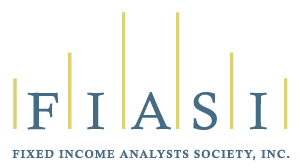Induction Of Leo C. O'Neill
Inducted November, 2003
By Richard S. Wilson
It is a distinct pleasure and honor to be here this evening to present to Leo C. O’Neill our society’s highest honor, induction into the Hall of Fame. The Hall of Fame was established in 1995 and tonight’s inductees are the 20th and 21st members. They are being recognized for a lifetime of achievement in the advancement of the analysis of fixed income securities.
Leo started out as an underwriter for Insurance Company of North America in Philadelphia but after a couple of years came to New York in 1968 and joined Standard & Poor’s as an equity analyst. He soon saw the light and went over to the corporate bond side of the business. He made steady progress rising through the ranks, becoming President in 1999. For many veterans of Wall Street, this is quite a remarkable accomplishment, being at ONE firm for 35 years, from youth through seasoned citizenship. A number of years ago I was having lunch at Harry’s with five other Wall Streeters. The six of us represented more than 35 firms and we still had years to go in the business!
I first met Leo back in 1971 when a couple of us from Drexel Firestone went up to S&P’s Hudson Street offices to talk about happenings in the corporate bond market. This was at the beginning of S&P’s widening the horizons of its analysts. They were open to these conversations and I think it was beneficial to both parties.
In 1975 Leo was promoted to Vice President of Corporate Finance and Chairman of the Corporate Bond Rating Board. In 1978 he became General Manager of Corporate Finance, in 1981 Group Vice President of Debt Rating Services which included corporate, municipal and international finance, and in 1984 Executive Managing Director of Debt Rating Services. Finally, in 1999 he became President of the whole kit and caboodle —- stocks, bonds, indices, publications, exchange-traded funds and much more — with over 5,000 employees. In 2002, S&P Financial Services contributed one-third of McGraw Hill’s $4.8 billion of operating revenue and it had an operating profit of $570 million, more than half of McGraw Hill’s $1.02 billion operating profit.
Now let’s look at some of Leo’s accomplishments over the years that have worked to the benefit of the fixed income community. A believer in transparent and open financial markets, under his leadership S&P established a bond seminar program in the late 1970s. They also took an important step of educating the market with the publication of its first book on rating criteria, high pointing their consistent ratings methodology. This was an invaluable tool for market participants and furthered the growth of S&P’s fine reputation. This was followed by scrapping the old Bond Outlook and the introduction of a much better and meatier publication, CreditWeek. Other rating criteria publications followed and were enthusiastically received. When you explain your rating methodology for older conventional debt instruments but especially for new derivative and structured securities, you give legitimacy to the ratings thus paving the way for the growth of these markets.
CreditWeek introduced the potential direction of ratings and this simple addition to ratings had an impact on sell-side fixed income research activities. Up to that time Street analysts tried to second guess the agencies on rating upgrades and downgrades. As a friend of mine recalls, Street analysts became less of a credit analyst and more of a bond analyst, spending more time with sales and trading and less time in the library. The sell-sider became more action or transaction oriented. This move to a profit center accelerated employment opportunities and improved compensation, sometimes at the expense of the agencies.
Recognizing the opportunities for global expansion where private debt markets were developing, Leo led the charge, opening a London office in 1984 and a Tokyo office in 1986. He now has offices in 19 countries under his wing. Over the last few years corporate governance has become almost a daily feature of our media reports. In 1998 S&P was the first to focus on corporate governance metrics.
Starting with a small group of analysts in a fairly small company in a small industry, not known by many people, and accused of being secretive and slow to react to change, the firm Leo now heads is a vastly different one than in the days of yesteryear. It is innovative and open and it has gained the respect of market participants and corporate and government leaders around the world.
Leo is an industry spokesman and a frequent speaker before academic, professional, regulatory and government groups, both here and abroad. He appeared on the cover of January’s CFO Magazine and has written a number of articles, most recently “Why Ratings Agencies Don’t Need Oversight.” for Career Journal.com. He serves on the board of a number of S&P subsidiaries; and is a member of The McGraw-Hill Companies Pension and Investment Committee.
Leo graduated from Hobart College in the Class of 1962 and in 1995 was awarded its alumni association’s Medal of Excellence for bringing “honor and distinction to his alma mater.”. He is treasurer and board member of Scenic Husdon, an organization devoted to preserving the beauty of the historic Hudson River Valley. He is a trustee of the Battery Conservancy as well as a member of the Executive Advisory Panel of the Open Compliance and Ethics Group Project. An avid golfer, Leo is a member of the Dutchess Golf and Country Club in Poughkeepsie and boasts of a handicap of around 13 or so (I guess depending on who he is playing against).
Probably no firm has contributed more to our society than S&P under Leo’s leadership. It was an early supporter allowing its members to join our ranks and its analysts at my last glance have 23 FIASI memberships. It has supported our major events over the years and is a corporate sustaining member. Therefore, on behalf of the members and board of the Fixed Income Analysts Society, I am proud to introduce to you FIASI’s friend, Leo C. O’Neill, and to present to him this engraved Tiffany crystal.








